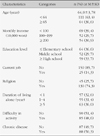Abstract
Purpose
This study was done to identify the prevalence of depression and determine the relationship of body mass index and perceived health status to depression for elderly women who live alone in the community.
Methods
A total of 175 adults aged over 60 participated in this cross-sectional descriptive study. Perceived heath status was measured using a self-report one-item questionnaire. Body mass index was calculated as weight in kilograms divided by the square of height in meters. Depression was assessed using the Korean short version of the geriatric depression scale. Hierarchical linear regression was used to identify associations between variables.
Results
Approximately 61.7% of elderly women who lived alone were depressed. The mean score for depression was 7.4 (SD 3.39). Hierarchical linear regression showed body mass index (β=.25, p<.001) and perceived health status (β=-.26, p<.001) were independently associated with depression adjusting for general characteristics. These two predictors accounted for 12% of the variance in depression.
Figures and Tables
References
1. Ahn EJ, Jang SK, Kim MS, Kim EA. The mediating effect of quality of sleep in the relationship between physical function and depression in communitydwelling older adults. J Korean Data Anal Soc. 2011; 13:681–693.
3. Choi HJ. A study on perceived health status, physical symptom, depression in the elderly of rural areas. Korean J Rehabil Nurs. 2008; 11:74–80.
4. Djernes JK. Prevalence and predictors of depression in populations of elderly. Acta Psychiatrica Scandinavica. 2006; 113:372–387.
5. Gavin AR, Simon GE, Ludman EJ. The association between obesity, depression and educational attainment in women: The mediating role of body image dissatisfaction. J Psychosom Res. 2010; 69:573–581.

6. Kee BS. A preliminary study for the standardization of Geriatric Depression Scale Short Form-Korea Version. J Korean Neuropsychiatr Assoc. 1996; 35:298–307.
7. Kim EK, Song JH, Hwang JY, Ahn KS, Kim JH, Koh YH. Obesity and depressive symptoms in elderly Koreans: Evidence for the 'Jolly fat' hypothesis from the Ansan geriatric (AGE) study. Arch Gerontol Geriatr. 2010; 51:231–234.

8. Kim JI, Choe MA, Chae YR. Prevalence and predictors of geriatric depression in community-dewelling elderly. Asian Nurs Res. 2009; 3:121–129.

9. Kim KB, Sok SR. Factors influencing depression of the elderly. J Korean Acad Community Health Nurs. 2009; 20:197–206.
10. Kim M, Kweon YR. Predictors of depression in residents of geriatric medical and welfare facilities. J Korean Acad Psychiatr Ment Health Nurs. 2010; 19:212–219.

11. Kim OS, Yang SJ, Kim JH, Kim NY, Jeon HO. Leisure activities, cognitive function and depression in female elderly. J Korean Acad Adult Nurs. 2007; 19:436–446.
12. Kim YJ. Comparison of health habits, perceived stress, depression, and suicidal thinking by gender between elders living alone and those living with others. J Korean Acad Fundam Nurs. 2009; 16:333–344.
13. Korea National Statistical Office. Korea National Statistical Office Statistics: 65 years over population ratio. 2010. Retrieved August 19, 2010. from http://www.kostat.go.kr.
14. Korean Society of Obesity. Report on cut-off point of BMI and waist circumference for criteria of obesity and abdominal obesity among Korean. Seoul: Korean Society of Obesity;2005. 10.
15. Lee YH, Shin MH, Kweon SS, Choi SW, Ryu SY, Rhee JA. Prevalence and correlates of depression among the elderly in an urban community. J Agric Med Community Health. 2008; 33:303–315.

16. Li ZB, Ho SY, Chan WM, Ho KS, Li MP, Leung GM. Obesity and depressive symptoms in Chinese elderly. Int J Geriatr Psychiatry. 2004; 19:68–74.

17. Lim J, Kim S, Ke S, Cho B. The prevalence of obesity, abdominal obesity and metabolic syndrome among elderly in general population. Korean J Fam Med. 2011; 32:128–134.

18. Lin QL, Kim HK, Ann JS. Relationship between depression and quality of life in elderly women in living alone: The moderating and mediating effects of social support and social activity. J Korean Gerontol Soc. 2011; 31:33–47.
19. Moon MJ. Factors influencing depression in elderly people living at home. J Korean Acad Nurs. 2010; 40:542–550.

20. Park SY. A study on depression, ADL, IADL, and QOL among community-dwelling, low income elderly. J Korean Acad Public Health Nurs. 2009; 23:78–90.
21. Park YH, Suh EY. The risk of malnutrition, depression, and the perceived health status of older adults. J Korean Acad Nurs. 2007; 37:941–948.

22. Roberts RE, Deleger S, Strawbridge WJ, Kaplan GA. Prospective association between obesity and depression: Evidence from the Alameda county study. Int J Obes Relat Metab Disord. 2003; 27:514–521.

23. Russell D, Taylor J. Living alone and depressive symptoms: The influence of gender, physical disability, and social support among hispanic and non-hispanic older adults. J Gerontol B Psychol Sci Soc Sci. 2009; 64:95–104.

24. Salihu HM, Bonnema HM, Alio AP. Obesity: What is and elderly population growing into? Maturitas. 2009; 63:7–12.
25. Seo JM, Kim MH, Kim JS. Discriminating power of depression of elderly women by arthralgia, physical function and physical self-efficacy. J Korean Acad Psychiatr Ment Health Nurs. 2006; 15:237–245.
26. Sheikh JI, Yesavage JA. Geriatric depression scale (GDS), recent evidence and development of a shorter version. Clin Gerontol. 1986; 5:165–172.
27. Song MS, Kim NC, Lee DH. Factors related to depression and activities of daily living in elders with symptoms of depression. J Korean Gerontol Nurs. 2008; 10:20–26.
28. Tanaka H, Sasazawa Y, Suzuki S, Nakazawa M, Koyama H. Health status and lifestyle factors as predictors of depression in middle-aged and elderly Japanese adults: A seven-year follow-up of the Komo-lse cohort study. BMC Psychiatry. 2011; 11:1–10.
29. Xu Q, Andersen D, Lurie-Beck J. The relationship between abdominal obesity and depression in the general population: A systematic review and meta-analysis. Obesity Research & Clinical Practice. 2011; DOI: 10.1016/j.orcp.2011.04.007 [in press].

30. Yoon DH, Park JH, Jo SC, Park MJ, Kim SS, Choi SH. Depressive symptomatology and metabolic syndrome in Korean women. Korean J Obes. 2005; 14:213–219.




 PDF
PDF ePub
ePub Citation
Citation Print
Print







 XML Download
XML Download